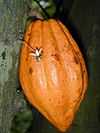Chocolate bar

A chocolate bar is a confection in bar form comprising some or all of the following components: cocoa solids, cocoa butter, sugar, and milk. The relative presence or absence of these components form the subclasses of dark chocolate, milk chocolate, and white chocolate. In addition to these main ingredients, it may contain emulsifiers such as soy lecithin and flavors such as vanilla.
In most of the English-speaking world, chocolate bar also refers to what is typically called a candy bar in American English. This is a form of confectionery usually packaged in a bar or log form, often coated with chocolate and sized as a snack for one person. But within that term, a wide variety of products exist, ranging from solid chocolate bars to multiple layerings or mixtures of ingredients such as nuts, fruit, caramel, or fondant containing no chocolate.
Certain brands of chocolate bars and candy bars are sold as being for nutritional supplementation purposes. These bars contain protein and various vitamins while still retaining a sweet taste.
History
Up to and including the 19th century, confectionery of all sorts was typically sold in small pieces to be bagged and bought by weight. The introduction of chocolate as something that could be eaten as is, rather than used to make beverages or desserts, resulted in the earliest bar forms, or tablets. At some point, chocolates came to mean any chocolate-covered sweets, whether nuts, creams (fondant), caramel candies, or others. The candy bar evolved from all of these in the late-19th century as a way of packaging and selling candy more conveniently for both buyer and seller; however, this "convenience" did not include price, of course, as the buyer had to pay for the packaging. It was considerably cheaper to buy candy loose, or in bulk.
In 1847, the Fry's chocolate factory, located in Union Street, Bristol, England, moulded the first ever chocolate bar suitable for widespread consumption. The firm began producing the Fry's Chocolate Cream bar in 1866. Over 220 products were introduced in the following decades, including production of the first chocolate Easter egg in UK in 1873 and the Fry's Turkish Delight (or Fry's Turkish bar) in 1914. In 1896, the firm became a registered private company and was run by the Fry family, with Joseph Storrs Fry II, grandson of the first Joseph Storrs Fry, as Chairman.
By 1910 in Canada, the Ganonge Brothers Limited in St. Stephen, New Brunswick had developed and begun selling the modern chocolate bar.
Although chocolate bars and candy bars had their beginnings in the 19th century, it was in the early-20th century that this confectionery commercial venture grew most rapidly.
During the first half of the 20th century in the U.S., there were thousands of different candy bars being manufactured and distributed locally or regionally by small candy companies. Some of these still survive, but a few major manufacturers have taken over the marketplace by buying up smaller companies and reproducing the most popular of their candy bars. Today, candy bars are made and consumed all over the world and are manufactured to local tastes and environmental conditions.
The world's largest chocolate bar weighed in at 5,792.50 kg, measuring 4m by 4m by 0.35m and was manufactured by Thorntons plc (UK) on 7 October 2011.[1]
See also
References
- ↑ Guinness World Records "Largest chocolate bar" http://www.guinnessworldrecords.com/world-records/1/largest-chocolate-bar-Accessed 22/10/2013
Further reading
- Almond, Steve (2004) Candyfreak, Algonquin Books of Chapel Hill, ISBN 1-56512-421-9
- Broekel, Ray (1982) The Great American Candy Bar Book, Houghton Mifflin Co., ISBN 0-395-32502-1
- Richardson, Tim (2002) Sweets: A History of Candy, Bloomsbury, ISBN 1-58234-307-1
External links
| Wikimedia Commons has media related to Chocolate bars. |
| ||||||||||||||||||||||||||||||||||||
